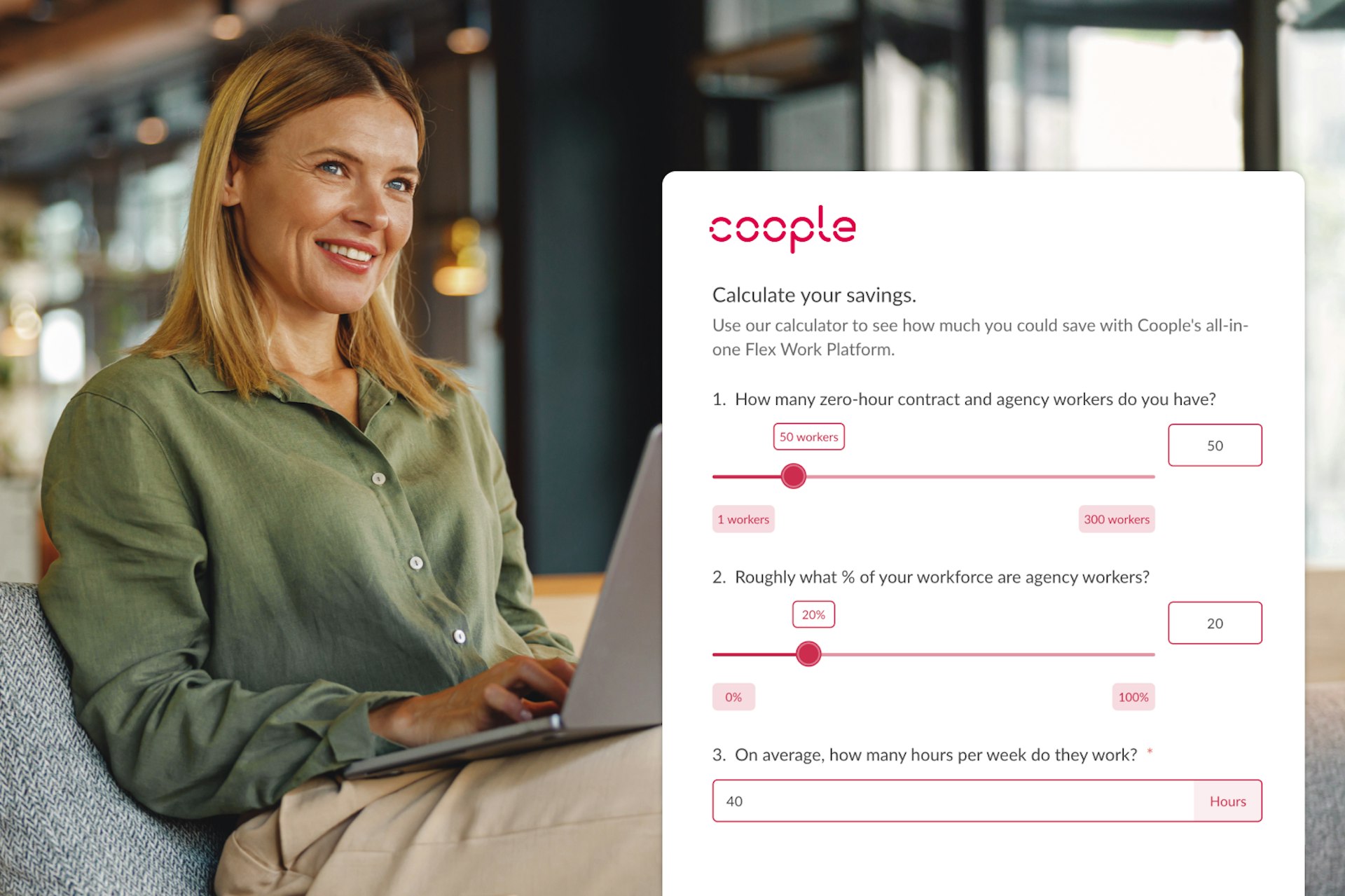
Coople is now offline from 1 Jan 2026. If you need support with existing shifts or any outstanding queries, please visit our help centre or get in touch. All outstanding Coople shifts will be paid and settled.Existing client login

Many organisations focus on the hourly rate for temporary workers but overlook the hidden costs of managing them: the hours spent on planning, scheduling, chasing last-minute changes, and dealing with no-shows.
These indirect costs can add up quickly, cutting into margins and creating unnecessary stress for your team.
As Rick Jones of PwC UK notes, “the rises in the National Living Wage and the continued competition for labour mean payroll will be the biggest operational cost challenge for UK operators.” Even small inefficiencies in planning and coordination can significantly eat into profits in this environment.
That’s why Coople has created a staffing cost calculator. This free tool is designed to shine a light on the true cost of managing a flexible workforce, including the time, money, and admin you might not even realise you’re spending.
It’s easy to think only about the hourly rate you pay external staff, while overlooking the hours spent planning, scheduling, and managing last-minute changes.
Coople’s staffing cost calculator is designed to reveal your true hourly cost, including those hidden planning and coordination hours that often go unnoticed. By taking these factors into account, you’ll see a much clearer picture of what your flexible workforce is really costing you.
With this knowledge, you can:
While no calculator can account for every nuance of your business, it’s a powerful way to benchmark costs, surface hidden inefficiencies, and spark more strategic conversations about how your team manages flexible staffing.
Every question is there for a reason, offering a new lens on where your time and money really go.
Here’s what you’ll answer and why it matters:
1. How many flexible workers do you have?
Why it matters: The size of your flexible workforce directly impacts your complexity and cost. If you manage 30+ temporary workers, even small inefficiencies, like late shift updates or scheduling back-and-forth, can quickly add up. Understanding the scale helps you quantify just how much admin effort is being spent behind the scenes.
2. What percentage of your workforce are agency workers?
Why it matters: Agency workers typically come at a premium and they also require extra coordination. If 50% of your workforce is sourced via agencies, there’s a significant opportunity to reduce costs by streamlining how they’re scheduled, tracked, and managed.
3. On average, how many hours per week does your flexible worker work?
Why it matters: Shift length affects your total spend, workload distribution, and coverage risks. A large number of short shifts, for example, can result in higher churn and more admin time, while longer shifts may increase fatigue and absence rates. This figure helps surface where inefficiencies may be hiding.
4. What’s the average hourly rate you pay agency workers?
Why it matters: This is your base labour cost, but it’s only the starting point. Once admin time and rescheduling effort are factored in, your real hourly cost can be significantly higher. This question helps uncover the full financial picture.
5. How do you currently schedule zero-hour and agency workers?
Why it matters: Using spreadsheets, messaging apps, or manual tools might feel manageable, but these methods often cause errors, delays, and duplicated effort. For example, a rota shared via WhatsApp might seem fast, but chasing confirmations and last-minute changes burns valuable time.
6. How many hours per week does your team spend on workforce planning?
Why it matters: Planning doesn’t just happen in meetings, it’s in every rota update, every phone call, and every shift swap. Even a conservative estimate (say, 10 hours a week) adds up to hundreds of hours annually. Capturing this helps you visualise the real cost of “routine” planning.
7. What’s the approximate salary of the main person managing flexible workforce planning?
Why it matters: If the person managing the rota earns £40,000/year, every hour spent on manual admin is a high-cost activity. Even small improvements in efficiency can unlock significant savings when you account for their time properly.
8. How often do you face last-minute shift changes, no-shows, or urgent gaps?
Why it matters: Last-minute absences cost more than just stress, they can lead to rushed decisions, missed revenue, or paying agency premiums. If these disruptions happen regularly, you’re likely spending more than you think just to “patch holes.”
Even before you see the final result, you’ll gain valuable insight into where your staffing strategy might be leaking time and money, and how you could address it.
Once you complete the questions, our staffing cost calculator delivers clear, actionable insights tailored to your business.
Here’s what you’ll learn:
These insights give you a solid foundation to build a more efficient, cost-effective, and resilient staffing approach.
By surfacing hidden planning costs and revealing your actual hourly rate for external staff, you’ll be better equipped to make informed decisions that save money and reduce operational stress.
While no calculator can capture every nuance of your staffing setup, this tool gives you a clear starting point. It’s designed to highlight cost patterns, inefficiencies, and opportunities you may not have seen - so you can take smarter, data-backed action.

Optimise staffing with smart workforce management solutions that cut costs, boost productivity, and adapt to changing business demands.

Discover how Coople supports retail workforce planning, helping businesses manage staffing costs effectively in challenging economic times.

Different industries experience seasonal peaks at varying times throughout the year. During the summer, many businesses face the dual challenge of increased customer demand and higher volumes of staff on annual leave. Making sure you have enough staff to cope with seasonal changes is an important part of keeping operations running smoothly day-to-day.